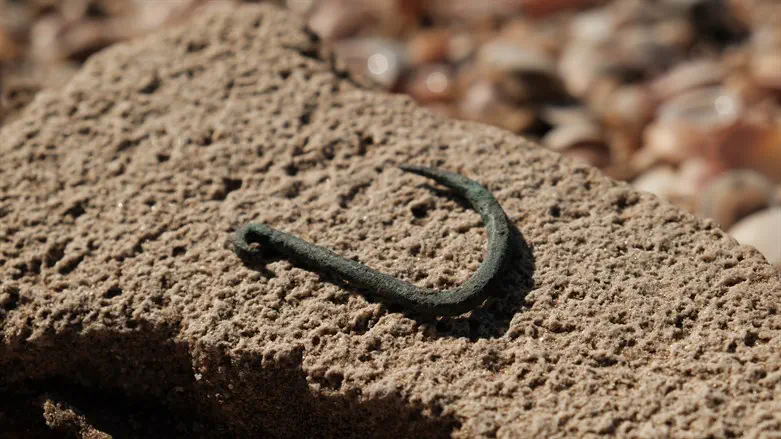
An ancient copper fishhook believed to be well over five thousand years old — making it one of the oldest known in the world — has been discovered in the Israel Antiquity Authority excavations carried out prior to the construction of the new Agamim neighborhood in Ashkelon in 2018. The find will be exhibited for the first time ever on April 3rd at the 48th Archaeological Congress, organized by the Israel Antiquity Authority, the Israel Exploration Society and the Israeli Archaeological Association.
According to Dr. Yael Abadi-Reiss, co-director of the excavation together with Dr. Daniel Varga, both from the Israel Antiquity Authority, “This unique find is 6.5 cm long and 4 cm wide, its large dimensions making it suitable for hunting 2–3 m long sharks or large tuna fish. Other ancient fishhooks found previously were made of bone and were much smaller than this one. The use of copper began in the Chalcolithic period and it is fascinating to discover that this technological innovation was applied in antiquity for the production of fishhooks for fishermen along the Mediterranean coast.”
In the Chalcolithic period, there were large villages around Ashkelon, whose economy was based on branches of agriculture still common today, such as the pasturing of sheep, goat and cattle, the cultivation of wheat, barley and legumes and the tending of fruit orchards. “We learn about the dietary habits of the people who lived here [almost] 6,000 years ago from the remains of animal bones found in ancient rubbish pits, from burnt wheat grains found in ovens, and from the hunting, cooking and food-processing tools retrieved, including flint sickles, and a variety of pottery vessels that served for the storage, cooking and the conservation of food by fermentation and salting. The rare fishhook tells the story of the village fishermen who sailed out to sea in their boats and cast the newly invented copper fishhook into the water, hoping to add coastal sharks to the menu,” says Dr. Abadi-Reiss.
The research on the copper fishhook is being undertaken by Dr. Yotam Asscher of the Israel Antiquity Authority and Magda Batiashvilli, and we await new discoveries on this fascinating artifact. Advanced technologies are available for today’s scholars, opening up a world of new questions that could not previously be answered.
According to Eli Escusido, Director of the Israel Antiquity Authority, “We are very excited that the Israel Antiquity Authority will host the Congress participants in the new home of Israel archaeology- the Jay and Jeanie Schottenstein National Campus for the Archaeology of Israel in Givat Ram, Jerusalem. A modern visitors’ center will be set up for the general public, enabling a glimpse “behind the scenes” of the extensive archaeological activity that takes place in Israel, and a view of some of the wonderful treasures that come to light from underground.”
